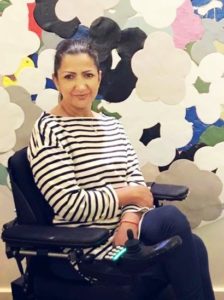My name is Meena Dhanjal Outlaw. You may already have read my story about how I sustained a spinal cord injury from falling from the balcony of my home in January of 2000. As a new high-functioning paraplegic woman, I had to go through a lot of challenges and changes. Although as it turns out, plenty of obstacles would be thrown in my path, including a diagnosis of Myasthenia Gravis. Since it’s Myasthenia Gravis Awareness Month, I’d like to share my experience with this neurological disorder.
Being Diagnosed with Myasthenia Gravis
5 years ago, I saw some specialists for some new complications I was experiencing, such as muscle weakness, extreme eye glare from the sun that sunglasses wouldn’t help, and more. After running some tests, the ophthalmologist referred me to a neurologist, who ran even more tests. This doctor diagnosed me with another incurable condition on top of my spinal cord injury.
I was told I had Myasthenia Gravis, a neuromuscular autoimmune disease that causes severely debilitating muscle weakness.
 Of course, my first question was what is Myasthenia Gravis (MG)? It’s a rare chronic disease characterized by muscular weakness without atrophy. It’s caused by a defect in the action of acetylcholine at neuromuscular junctions. According to the Myasthenia Gravis Foundation of America, it’s a somewhat rare condition that affects about 20 out of every 100,000 people in the United States.
Of course, my first question was what is Myasthenia Gravis (MG)? It’s a rare chronic disease characterized by muscular weakness without atrophy. It’s caused by a defect in the action of acetylcholine at neuromuscular junctions. According to the Myasthenia Gravis Foundation of America, it’s a somewhat rare condition that affects about 20 out of every 100,000 people in the United States.
The only thing stopping me from completely breaking down emotionally at the news was that I already had 14 years of experience in living with a disability.
The doctor prescribed a drug called Mestinon, which helps with MG symptoms, as well as prednisone (a steroid medication).
However, that was only the beginning of my journey with MG.
Symptoms of Myasthenia Gravis
Myasthenia Gravis can present itself differently in different people. Some of the common symptoms people may experience may include:
- Muscle weakness
- Drooping eyelids
- Blurry or double vision
- Difficulty breathing, swallowing, and chewing
- Difficulty walking or moving
Many of those affected by MG use assistive devices like wheelchairs, walkers, and canes. Some are more susceptible to falling and might need braces.
Getting Worse Before Getting Better
I wasn’t sure where to turn for help. I had spoken to a fellow spinal cord injured peer who recommended a specialist. However, this specialist had a six-month-long waiting list. When I looked up my condition on the internet, I found information that was either too technical or scary.
As my symptoms began to worsen, I began canceling obligations and growing distant from my friends. I just couldn’t seem to keep up with life.
I grew so weak. My eyes would even close up by themselves sometimes. My upper body, in particular, began experiencing severe muscle weakness. My fingertips would curl as I typed on my laptop, then my arms would feel like jelly.
As I began to progress, one of my friends lent me her power wheelchair because I could no longer push the wheels on my manual wheelchair. I was getting unable to drive because my vision was blurry, so my husband started taking time off work to take me to the doctor.
When my mother flew in from London, she was terribly concerned when she saw how I was in bed and could barely do anything. I couldn’t sit up without help. I couldn’t chew my food without it getting stuck. My throat felt like it was closing up. Then I began to have trouble speaking.
That was when I remember thinking that I needed to make sure my will was in place and that whatever I had must be terminal.
Finding Support and Hope
Medical Care
Thankfully, I met with my rehabilitation doctor, who was surprised by my weak condition. I broke down in the exam room, but the doctor and the nurse didn’t judge me. Even though I felt silly, the nurse held me close. I remember begging the doctor to help me.
He let me know that he had other spinal cord injured patients who were also living with Myasthenia Gravis and were better after treatment. I instantly felt relieved.
While I went through a few more ups and downs, I got in contact with a neurologist who properly diagnosed me with General Myasthenia Gravis. They also helped me find out what type of antibody I had and what would be the best treatment for me. Finally, I learned that it is best to treat this disease very aggressively right away.
Rehabilitation Therapy
After two months, I was feeling more stable, although I wasn’t out of the woods yet. I asked to be transferred to my old rehabilitation hospital who helped me so much when I was first injured. Well, they did it again. Thanks to their dedicated care and help, I went home better equipped to help myself. I could take care of my kids again too, although I was slower than before.
I could even self-catheterize again with some new limitations. I even learned from my medical supplier that I would be eligible for sterile closed system catheters since I am even more susceptible to infections like UTIs now.
Support Groups
Soon, I found a Myasthenia Gravis support group in Houston, Texas. When I contacted the leader, she talked to me about my symptoms. We both had a different type of Myasthenia Gravis. This is why it is known as the “Snowflake Disease.”
“No two snowflakes are alike,” she told me. “They are each unique…just like our symptoms.”
The support group has been a wealth of knowledge and help. I really do believe that things do not happen by coincidence and that somehow people are placed in our lives for a reason and a season.
If you’re living with Myasthenia Gravis, I cannot recommend peer support enough. Getting involved in the community helped me meet many other Myasthenics who live and thrive with positivity, even on the days when we don’t feel so good.
Living with Myasthenia Gravis Today
 Today, I still deal with symptoms and issues, although it’s not nearly as terrifying as it was in the beginning. I can’t get into the shower by myself, and heat greatly affects me. I still need help getting on and off the commode. The more I move, the quicker I can tire out.
Today, I still deal with symptoms and issues, although it’s not nearly as terrifying as it was in the beginning. I can’t get into the shower by myself, and heat greatly affects me. I still need help getting on and off the commode. The more I move, the quicker I can tire out.
The social stigma surrounding invisible illnesses and disabilities like MG is that people affected are just being lazy or unreliable. Hopefully, my experience shows others that this is simply not true.
I’m not cured. However, I’ve come a long way. The treatment is working. Additionally, regular physical therapy helps me build my health and strength. It will take baby steps, but perhaps someday I will even be able to get back in my manual chair with a smart drive.
If you think you may have Myasthenia Gravis, see a doctor for a proper diagnosis. Prompt and proper treatment will be the biggest help in turning your symptoms around.
Myasthenia Gravis Resources
Myasthenia Gravis Foundation of America
MGFA Myasthenia Gravis Support Group of Greater Houston
If you need intermittent catheters due to your spinal cord injury, Myasthenia Gravis, neurogenic bladder, or another condition, 180 Medical has got you covered. Whether you are able to self-catheterize or if you have a caregiver who caths you, the caring Product Specialists on their staff can help you find the right catheter products for your unique needs. They also offer compassionate personalized service that will help you out during difficult times.
